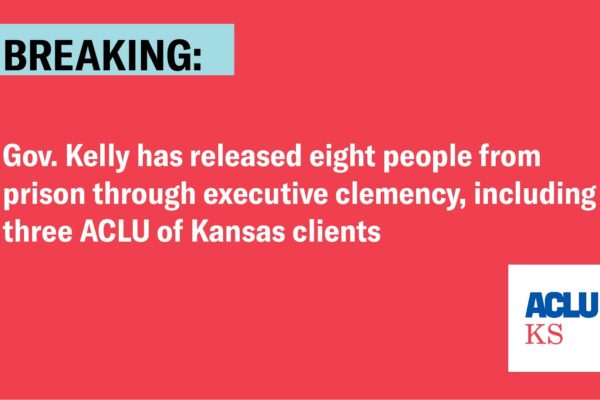This resource is intended to help impacted individuals advocate for themselves or family members, including filing for an application for early release through executive clemency on their own behalf. The ACLU of Kansas will continue to push for a paradigm shift in which redemption is the standard. Everyone is more than their worst mistake.
Filing for Clemency: A Toolkit
Filing for Clemency while Incarcerated Toolkit
EXAMPLE Clemency Application Packet
Executive Clemency Application (blank).
What is Clemency?
In Kansas, executive clemency is early release granted by the Governor. The process is governed by K.S.A. § 22-3701. There is no significant distinction between “clemency” and a “pardon.” A clemency application is different from an appeal, which goes through the courts. Receiving clemency does not remove the underlying convictions from an individual’s record.
What is the process for applying for clemency?
To apply for clemency, an individual must do the following, using documents from IMPP 23-101A :
1. Provide notice to the county judge and prosecutor within any county of convictions.
2. Provide notice to the public through a publication (e.g., a newspaper) in the county.
3. Complete the application with reasons for seeking clemency, with detailed information regarding release plans and the person’s conduct and adjustment since conviction.
4. Submit the application to the Kansas Prisoner Review Board, which then has 120 days to review before sending the application to the Governor for a decision.
What should I expect after filing for clemency?
After the Prisoner Review Board receives an application for clemency, the Board has 120 days to finalize its review before sending the application to the Governor’s office for the final decision. There is no time limit or requirement for the governor to make a decision on an application for executive clemency.
Do I need a lawyer or the ACLU of Kansas in order to file for clemency?
No. You do not need legal representation to file an application for executive clemency. You may file for clemency yourself by obtaining all of the relevant paperwork and further details in IMPP-23-101A through your Unit Team Manager. Or, you can have a loved one file on your behalf using the same documents.
Why did the ACLU of Kansas make these toolkits?
We know that Kansas incarcerates too many people, often with some of the harshest sentences in the country. Executive clemency provides an opportunity to correct injustice in the law and/or demonstrate that continued incarceration of a person is not within the state’s interest. We want everyone to be aware of this process and how to advocate for themselves when they believe they are deserving of early release.
Related Issues
Related Publications
Related Content

Gov. Kelly releases three ACLU of Kansas Clemency Project clients, paving the way for many more such releases
Stay Informed
Sign up to be the first to hear about how to take action.
By completing this form, I agree to receive occasional emails per the terms of the ACLU’s privacy statement.
By completing this form, I agree to receive occasional emails per the terms of the ACLU’s privacy statement.
